All about gladioli: species, varieties, cultivation and use
Bright tall candles, standing proudly in different parts of the garden, attract everyone's attention. Such interesting flowers are called proudly gladioli... Extraordinary inflorescences amaze with their splendor, various shades and volumes.
Florists need to know everything about gladioli in order to grow them properly. Since growing flowers is not difficult, it has some nuances. The main thing is that before planting it is worth deciding on the variety and choosing a certain variety of beautiful erect gladioli.
Content:
- The best types and varieties of gladioli
- Reproduction methods
- Landing dates and rules
- Flower Care Tips
- Diseases and pests
- Harvesting and storage of bulbs
- Application in site design
The best types and varieties of gladioli
Gladiolus comes from the ancient genus Iris, is a bulbous type that grows in one place for a long period of time, a perennial. Its name among the people is a sword. The natural habitat of the representative of bulbous plants is Africa, Europe, the Mediterranean, Siberia, mainly the western regions and Central Asia. In the years when the world was just developing (300 BC), the beautiful flower was better known as a weed that grows in wheat fields.
Over time, the beauty and advantages over other inflorescences were recognized and flowers appeared in the gardens of noble nobles and high-ranking officials of that time. The flower is now easy to grow in any garden or plot.
In nature, there are about 200 different species and varieties of beautiful perennial shrubs.
The stems of gladioli are erect, not subject to branching. Only one stem grows from one bulb, on which deciduous plates are located below, and inflorescences bloom at the top with a candle. The height of one plant varies depending on the variety and growing conditions within the range of 50-150 cm. The foliage has a linear shape or can stand out as xiphoid. One leaf reaches a length of 50-75 cm on average. The inflorescences in the upper part are placed in different ways: collected unilaterally, bilaterally, or bloom in a spiral.
After the buds have bloomed, a fruit is formed in place of the flower, isolated in a tricuspid type box. Seeds are placed inside the fruit. They are represented by a brown shade of round shape or oval size. Dwarf and hybrid shrubs are most popular when grown in personal plots, but some varieties of wild perennials are also used in gardening.
The following wild-growing inflorescences are distinguished:
- Marsh - has a thin stem not exceeding 60 cm in height. It has medium-sized dark purple inflorescences, up to 8 cm in diameter. Most often it is used to create alpine slides or is located next to a reservoir.
- Byzantine - does not exceed 45-65 cm in height. The flowers are insignificant in diameter - up to 6 cm. It has a tone that varies from crimson to purple in color. Placing flowers - one-sided, perfectly placed in mixborders.
- Kochi - flowers are located on a rather thin, but strong stem, growing up to 60 cm. It does not have high inflorescences, it has few flowers, up to 8 pieces per stem.
- Ordinary - the stem is distinguished by its erect character, straight like a pillar, up to 1 m in height. The flowers are small - narrow-funnel, up to 4 cm in diameter. The tone of the inflorescences is purple-violet; they begin to bloom from the second half of spring.
- Sowing - a thin type, but strong in structure, the stem grows up to 80 cm. Flowers - bell-shaped, up to 10 pcs., Small in size (up to 4 cm). Have a light lilac tone or reach a bright pink hue. But in nature, this variety also occurs with other tones: yellow, blue-violet, red and even whitish.
Predominantly wild flowers have purple hues close to pink tones. Among the cultivated varieties, breeders distinguish 6 species of the hybrid type. The varieties stand out in the spring-winter development, and the rest - in the summer:
- Colville is a hybrid of small-flowered nature, flowering occurs early. The height of the stem reaches 90 cm, the foliage stretches to an average of 45 cm. The inflorescences are not large, funnel-shaped, up to 5 cm in diameter. They have the ability to be white, crimson with a rich tone or pale pink.
- Dwarf - a hybrid of Dutch selection, the stem is dense. But thin - up to 45 cm. Irregular inflorescences up to 7-10 cm in circumference, collected in loose inflorescences up to 10 buds. The color is predominantly light pastel colors. The most popular varieties are Elvira, Naomi, Charlotte, Alex, Tom and Thomas.
- Harlem - flowering begins earlier than other varieties, in early June. Stem - up to 75 cm, but not strong, breaks easily.
- Tubergena is a representative of the Dutch selection, which has thin leaves and a stem, up to 70-75 cm high. The buds are collected in inflorescences, 10 pieces per inflorescence, of a small volume - up to 8 cm.
- Primrose hybrid - gladioli of this type stretch up to 1 m.the foliage is yellow, the buds are not large - up to 6-10 cm, but due to the mass and concentration in a bunch - up to 16 pieces, a gorgeous spectacle is created.
- Hybrid - reaches up to 2 m in height, has inflorescences of different volume, varying from 5 to 20 cm in diameter. The color of the inflorescences is diverse and has the peculiarity of containing different tones.
The last variety includes the following types: Traderhorn, Shaka Zulu, Oscar, Great Temptation, Bimbo, Zizani, Stereo, Black Sea, Baccarat, Espresso, Red Square, Mystery of the Night, Arabian Knight, Black Surprise, Priscilla, Africa, Katerina, Dandy, Rose Stream, Pink Lady.
Reproduction methods
Reproduction of gladioli, regardless of the variety, occurs with the help of seeds, tubers and the method of dividing the bulb. Planting and germinating a plant with seeds is problematic. This method is used to obtain a new variety and is only used by breeders. It is possible to grow a plant from seeds, but this process takes a long period and does not always give the results that are expected. This is due to the fact that the seed material does not always retain its maternal qualities.
Reproduction by dividing the tuber is used only when the bulb does not provide the required volume of children. The gardener carefully cuts a splinter with a well-sharpened garden tool, so that sprouts remain on both sides of the knife. Otherwise, the tuber will no longer release leaf plates and the stem without a growth point.
The most optimal option for obtaining an identical copy of gladiolus is children.
They are annually formed by the mother torch in an amount of 4 to 20 pieces. as they grow older, they develop and increase in size, starting to bloom on their own. It is this planting material that retains up to 100% of its maternal qualities.
Landing terms and rules
To plant correctly gladioli and to get a gorgeous flower, it is recommended to adhere to the basic rules for growing the original inflorescence:
- It is not worth growing plants on the same site for 2 years in a row - they lose their rich shade, become smaller and begin to wither. The best option for planting will be clay soil. After a year of "sitting" in it, the plants should be transplanted into sandy loam soil. When planting in clay soil, it is worth adding humus additionally, and when planting in a sandy loam substrate, it is recommended to add humus.
- It is better to purchase planting material from neighbors who previously had inflorescences visible, their size. You should not take seedlings that are not suitable for the growing area. They will acclimatize for a long time in the indoor conditions and do not always bloom in the promised format with inflorescences. The purchased seedlings from Dutch nurseries decorate the garden plot only once - in the first year after planting. In the future, flowering can not be expected.
- Every year, after the buds have faded, the plants should be removed from the soil and the babies should be separated from the mother tuber. This is necessary due to the fact that in the future, a large bulb does not allow babies to develop, crushing them with its volume, absorbing all moisture and nutrients.
- When planting, take into account the volume of the bulb and deepen the planting material to a depth equal to 4 bulbs. It is worth planting tubers 15-20 cm apart, and the distance between the rows should be left no more than 40 cm.For children, the gap between the nodules up to 7 cm and between the rows - up to 15-20 cm is suitable.
- The optimal time for planting is from the first decade of May, in the southern regions this time comes much earlier: you can plant in February windows. It is best to monitor the weather conditions when the air temperature rises and reaches from +10 C and above, and the soil warms up to a depth of at least 10 cm.
- Before planting, a few days (up to 5) should prepare the tuber - you need to remove the excess husk from it. If the procedure is not followed, then the sprout may not break through the shell, which will lead to a lack of growth. Additionally, it is worth subjecting the torch to treatment with a growth stimulator (Kornevin, sodium humate or Immunocytophyte). If the planting material is purchased for the first time, then you should definitely treat it with a weak solution of Potassium Permanganate or Fundazol.
- When planting gladioli, it is worth remembering that these plants are photophilous, so they need to be placed only in open sunny areas.
- To prevent the development of fungal diseases, you do not need to plant tubers in lowlands or on poorly ventilated slopes in the shade.
Considering all the recommendations, gardeners get gorgeous plants that bloom for more than one year. At the same time, competently planted children begin to release the first buds, before reaching 3-4 years of age.
Flower Care Tips
Gladiolus is very picky about care. If you do not exercise supervision and constant care for him, he begins to quickly lose his original chic appearance. For long-term flowering, you should follow certain rules:
- Top dressing is necessary for a rich and bright shade of inflorescences. It is required to add nutrients every 10 days. The procedure is required starting from the second half of July. When the seedlings reach 10 cm in growth, they are fed with humus to prevent overheating and to stimulate long-term retention of moisture in the soil. With the development of 3 sheets, mineral dressing nitrogen-containing preparations. This is followed by 2 times in a row: during the formation of the 5th and 6th leaves, as well as at the time of bud development, introduce phosphorus and potassium.
- Watering - plentiful is required. After the initial planting, the area is spilled on which the tubers are located every other day. This is necessary for the peduncle to form qualitatively. If there is a dry summer, then watering is applied once a day, in the evenings.
- Loosening - carried out almost after every watering in order for the nutrient moisture to flow well to the root crop. Additionally, this procedure is necessary to prevent the formation of a crust on the surface, which does not allow the roots to be saturated with oxygen.
Additionally, you can spray the leaf plates of gladioli. But such events should be carried out only in the evening or early in the morning before the first rays of the sun appear.
Diseases and pests
Diseases of various types in gladioli can occur both with careful care and constant control of the gardener, and in the absence of such control. Not a single species is immune from problems. Infections can get on the plant, migrating from another crop.
Most often, a perennial from the Iris family is affected by such diseases as:
- Fusarium
- Rust
- Botrytis
- Septoriasis
All of these diseases are related to problems provoked by fungal spores. The fight against pathological bacteria should be started even at the moment of preparation of the planting material for burial. When 3 fully formed leaf plates appear, the plant is processed with Falcon or Horus. Usually the procedure is carried out before the beginning of the stage of inflorescence formation.
Also, the plant is often affected by pests. Most often on leaf plates and inflorescences can be found thrips or bulb mites. To eliminate them, it is immediately recommended to use Aktara, Balazo, Agrovertin or Confidor-maxim. To prevent the defeat of gladiolus by pathogenic bacteria or harmful parasites, you should carefully monitor the external condition of the plant. When the first signs of malaise are detected, it is immediately required to take action and not wait for further developments.
Harvesting and storage of bulbs
Cleaning and removing gladioli before the winter months is the most important task. This is required so that the babies mature normally and are well preserved. In central Russia, excavation is carried out 30-40 days after flowering for early and medium flowering periods and after 45-50 days for late varieties.
The weight of a quality baby is usually 30-60 grams. In some cases, the volume of children reaches 120 grams, and the largest ones have - 140 grams. The ripening of children while the bulb is in the ground will help remove excess leaves and faded inflorescences. Do not delay harvesting plants. This threatens that the babies will separate from the mother's tuber on their own and it will be difficult to find them in the ground.
Digging tubers from the ground, it is required to gently shake off the soil from the rhizomes, the peduncles are removed by 5-6 cm and the separation of the children from the mother's torch begins. For further cultivation, it is worth leaving only those nodules that are not less than 10 mm. The only exception is made for especially valuable varieties, leaving even children from 5 mm.
After removal and separation, it is required to thoroughly dry the received copies.
The procedure is carried out within 14-21 days at an elevated temperature of +26 .. + 30 C. After that, it is required to re-sort the planting material. Only healthy children should be left, which have even outlines and there is no visibility of rot or damage. Subsequently, babies and maternal tubers are stored in wooden boxes, the bottom of which is pre-lined with newspaper, at a temperature of +8 C. In such conditions, seedlings can lie for 2-3 years without losing their qualities and appearance.
Application in site design
Gladioli, when placed on a personal plot, can be distinguished into a separate flower bed. It will be interesting to plant various varieties on it in a kind of chaos or to highlight specific paths. Such mixborders are called gladiators.
When planting a plant in this way, it is worth adhering to moderation so as not to oversaturate the flower bed and not make it lurid.
The disadvantage in the flowering of gladiolus is its short duration.Therefore, when creating a flower bed, it is worth remembering that the beautification of a violent color is not long-lasting. Therefore, many gardeners decide to supplement the multi-level flower bed with broad-leaved plants, which will subsequently cover the empty stems of faded gladioli.
To land gladioli on mixborder it is recommended to follow the following landing pattern:
- The first to bloom in the spring hyacinths, tulips and daffodils.
- In the first half of the summer months, the flowerbed is covered with broad-leaved peonies, unique irises and small-colored chamomile.
- Then the original upright gladiolus blooms.
- In the first half of autumn, bright asters and chrysanthemums.
Such a flowering scheme allows you to get a bright bouquet of flowers at any time. It will be difficult for any visitor to take the eyes off such a zest on the site.
Thus, gladiolus acts as an interesting flower, which is not difficult to plant and embody caring for it. The main thing is to properly remove the mother tubers from the soil and prepare the children for planting. When you follow these simple rules, the gardener will receive a bright and colorful flower bed.
More information can be found in the video:



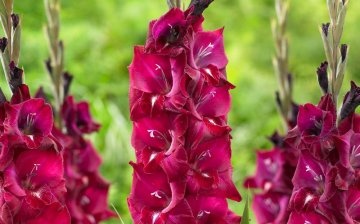
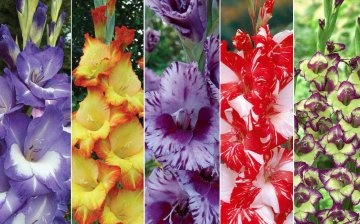
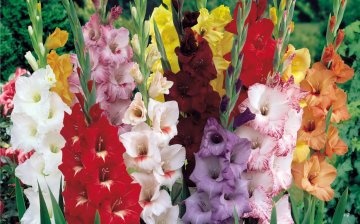

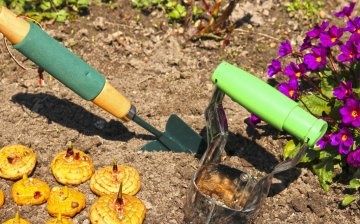
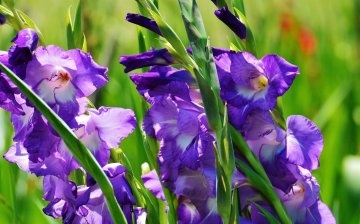

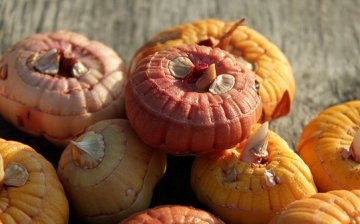
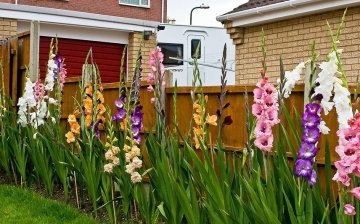









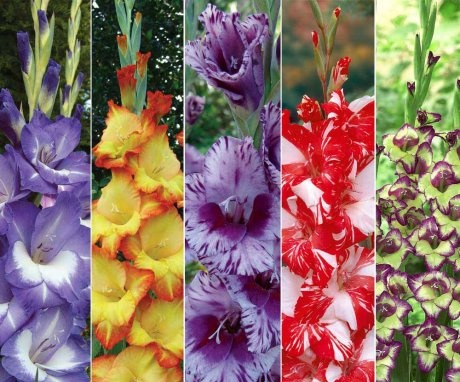
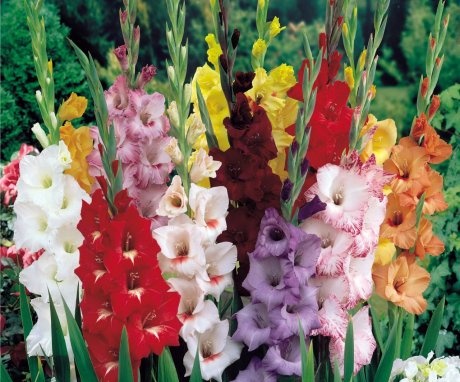
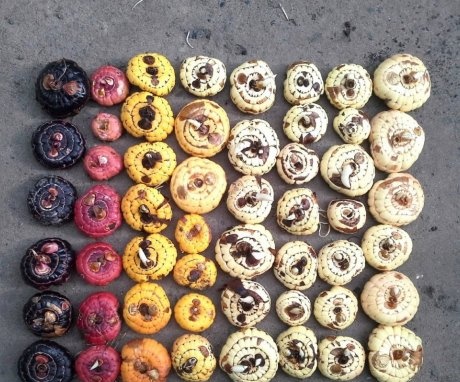
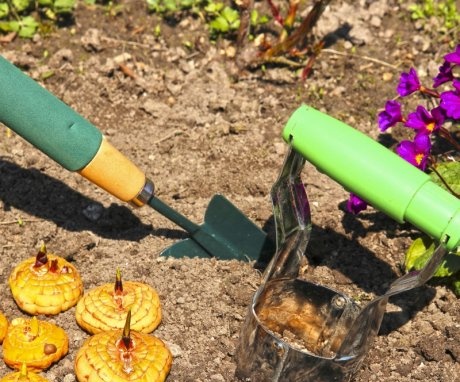
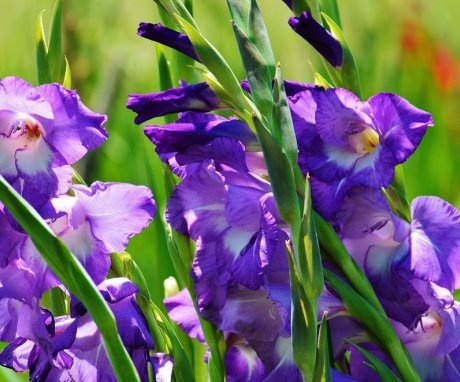

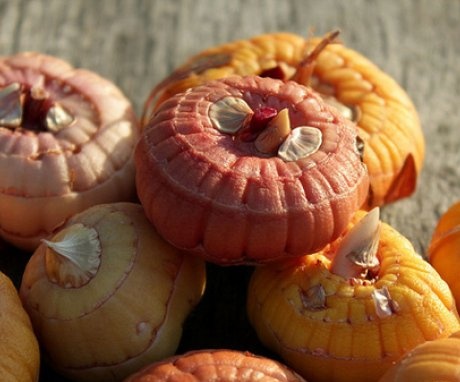
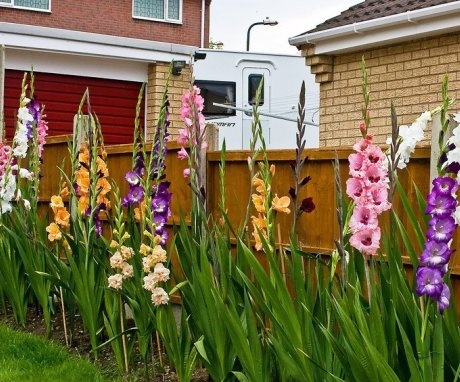
Gladioli have been decorating my front garden for a very long time, but I can't say that this is an easy task. They require special care and constant attention to themselves, from planting bulbs, care and ending with storage. I took the bulbs from the local store, and every year I experiment with different varieties. This is interesting enough.
Very beautiful flowers, but for some reason no one plants them in our country, apparently it is not easy to care for them and a beginner in this business will not be able to cope. Next year, I will definitely plant this plant in my country house.
Dear Lera1! There is nothing complicated in "distilling" gladioli. You just need to monitor watering. Our neighbor is engaged in the cultivation of gladioli for sale. So, the most difficult thing for him is to "adjust" the distillation to September 1. Otherwise, there are no problems with these colors.